The Originals: Manfred Thierry Mugler
- Oops!Something went wrong.Please try again later.
- Oops!Something went wrong.Please try again later.

PARIS — Manfred Thierry Mugler is having a moment.
Largely absent from the Paris fashion scene since he retired almost 20 years ago, the designer, who now goes by his birth name, is making a triumphant return to Paris Fashion Week this season — only not on the catwalk.
More from WWD
After a yearlong delay due to the coronavirus pandemic, the Musée des Arts Décoratifs is hosting a party on Tuesday to celebrate the opening of “Thierry Mugler: Couturissime,” the first major exhibition in Paris dedicated to the designer who helped define ’80s power dressing, launched the phenomenon of celebrities-as-models, and introduced a new fragrance category with Angel.
He was sometimes criticized for his extravagant designs, which often transformed the female body with the use of unusual materials like rubber, painted latex, Plexiglas and metal, receiving a few lumps from WWD.
Yet the designer’s legacy is solid, as the exhibition attests, and he remains active on several fronts: advising L’Oréal on his scent brand, mounting the cabaret revue “Mugler Follies,” as well as dressing celebrities like Cardi B and Kim Kardashian West for the red carpet.
Showing off his bulging biceps in a sleeveless top, Mugler spent more than an hour discussing his career, from his beginnings as a ballet dancer at the Opéra national du Rhin to his era-defining advertising photography.
And he didn’t mince words when it came to the #MeToo movement, or the return of the grunge aesthetic. “The world is tough enough. There’s enough ugliness in real life, there’s no need to add to it,” said the man raised on a diet of old Hollywood musicals.
Here, Mugler talks about risking his life for the perfect image, why he’s not done with fashion yet, and how he really feels about his body transformation.
WWD: The “Thierry Mugler: Couturissime” exhibition was a huge success in Montréal. How does it feel to finally be able to bring it to France?
Manfred Thierry Mugler: Above all, I’m very happy that such a harmonious selection of my work is being shown at the Arts Décoratifs, because my work is closely tied to sculpture, painting and all the other decorative arts.
WWD: Does Paris still have a special resonance for you?
M.T.M.: Yes, of course — this is where it all began. But I quickly moved on to the United States. New York is my home, just as much as Paris, and now Berlin. But Paris is a city that is known for putting on very sophisticated events, very beautiful exhibitions, so it feels right.
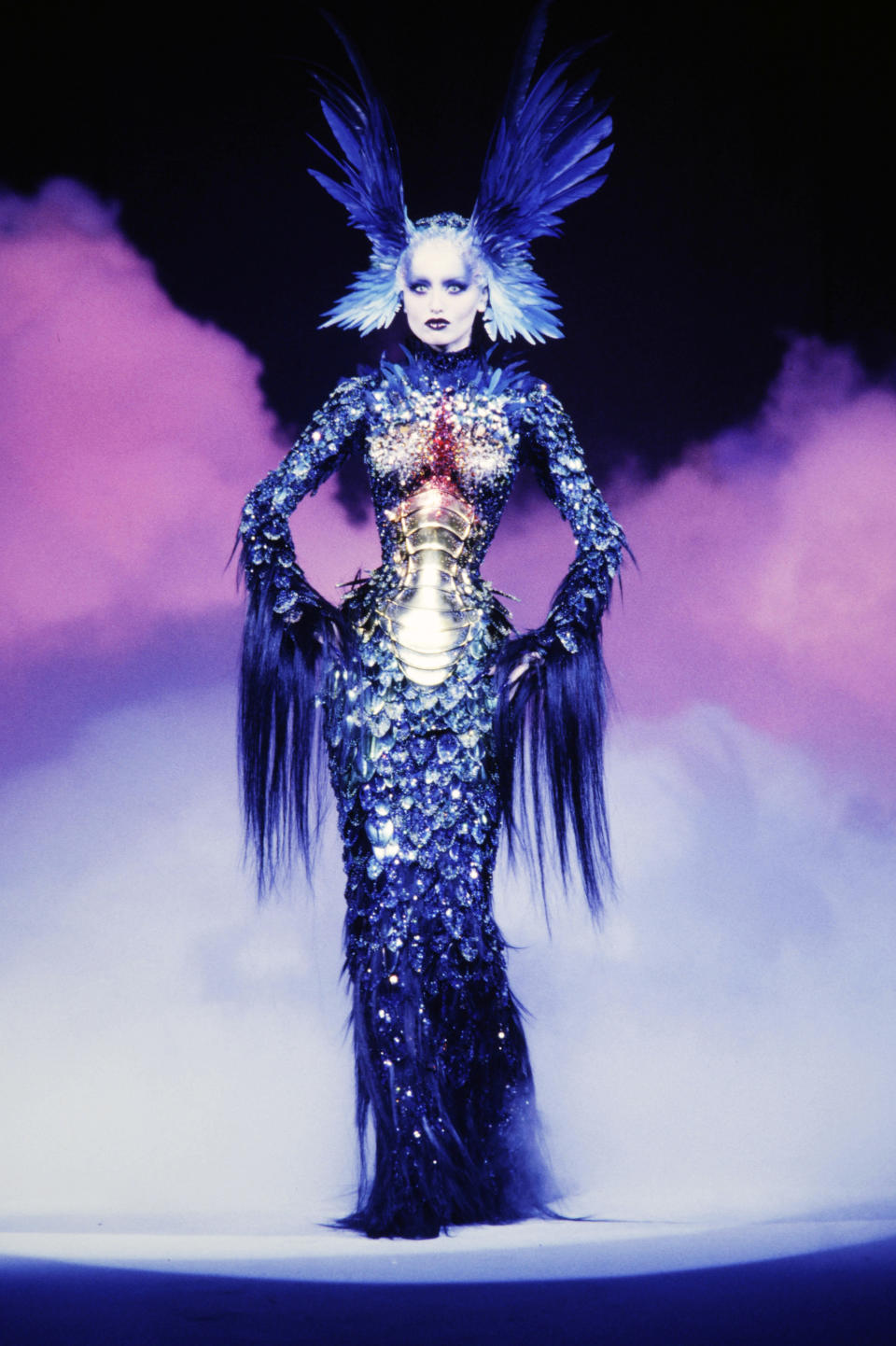
Giovanni Giannoni
WWD: You started your fashion career in London, where you contributed to the Swinging ’60s look of the trendy boutiques at that time. What was it like?
M.T.M.: It was creative, inventive and fun, and above all, it was a real social scene. On Saturday afternoons, all the young people strutted down King’s Road in incredible outfits.
It was all happening at the Chelsea Antiques Market and stores like Granny Takes a Trip, Biba and others. But Mr Freedom was more of a Pop Art-style boutique. It was very influenced by comic book art, which was really my thing. The hippie movement came later, but the center of the hippie scene in Europe was no longer London, it was Amsterdam, where I also lived for a while. I had a houseboat right in the center of Amsterdam, on the corner of Prinsengracht and Reguliersgracht. And then, of course, you had the big hippie hot spots like Kathmandu, Goa, Kabul and all that.
During my hippie period in India, I studied Kathakali dance in Kerala. I was even baptized in the Hindu faith.
WWD: How did you make the jump from all this globe-trotting and visual opulence to developing your streamlined, body-conscious aesthetic?
M.T.M.: That was [the influence of] Paris, with its sense of elegance and chic. My masters in fashion were Cristóbal Balenciaga and Christian Dior, but also Ossie Clark during his heyday in London, and in New York, Charles James.
I wasn’t sure what I wanted to do, but fashion took off for me very quickly in Paris, as soon as I showed my sketches. My first job in Paris was at Gudule, which was the hippest store in Paris, on the Left Bank. I was hired on the basis of my look.
I had an appointment with the big boss. She checked me out from the other end of the studio, looked me up and down, didn’t even look at my sketches, and said: “You start on Monday.’’
Back then, fashion was in full folklore mode. Kenzo was all the rage, so you had Peruvian influences, Indian influences and what have you. It was all very folkloric, and all I wanted to do was this very pure, Parisian silhouette: the little black suit, the trenchcoat, the black dress, the siren dress. I did the first nude body-conscious dress. Nobody was doing nude at that time. My first ready-to-wear line was called Café de Paris, and it was all about a very precise, streamlined silhouette, very strongly influenced by dance.

WWD
WWD: You often worked with models with almost unreal proportions, like Nadja Auermann, but you were also one of the first to hire diverse models, featuring older women, curvy models and those breaking with the boundaries of dress traditionally associated with their gender on the runway. What’s your ideal of beauty?
M.T.M.: It’s above all an emotional impact, a personality, a character — something harmonious. I’m very drawn to architecture and the structure of the human face, so I search for beauty of all types, regardless of geographical origin. I like to find a true example, or an extreme, for every type of beauty. That’s always felt instinctive to me, but it’s also from having traveled a lot. The beauty of people, whether they come from China, Africa or America, just blows me away.
When I was in China in the ‘80s, when it was still under hardline Communist rule, the government gave every Chinese citizen three days off to come to Beijing and see the sights, such as the Great Hall of the People and Mao’s tomb. On Tiananmen Square in Beijing, you would see the most incredible mix of ethnicities.
In Nanjing, everyone would set off for work on their bicycles at 6 a.m. Loudspeakers would be blaring these Socialist songs to motivate the workers. The more sophisticated ladies would wear veils made of synthetic chiffon to protect their skin, and the height of chic was to have it in color. In the morning fog — it was very cold and very polluted, too — you would see these creatures appear on their bikes with blue, red or green faces.
It’s all these visions. When you see the beauty of people deep in the Indian countryside, or Africa, or Europe, it’s profoundly moving. I’m not inventing anything. I’m just combining them in an explosive cocktail of beauty and magical moments that are there for the taking. I pay tribute to nature, and human beings and animals.
WWD: There’s been a lot of debate around your vision of women: some said you empowered them by giving them a superhero demeanor, others accused you of fetishizing women’s bodies. Do you think that, ultimately, you contributed to women’s emancipation?
M.T.M.: All I’ve ever done is strive toward that — absolutely. And sometimes I’m asked: “What is your definition of a powerful woman?” And I say, it’s a woman who’s truly free — who enjoys herself and who’s happy.
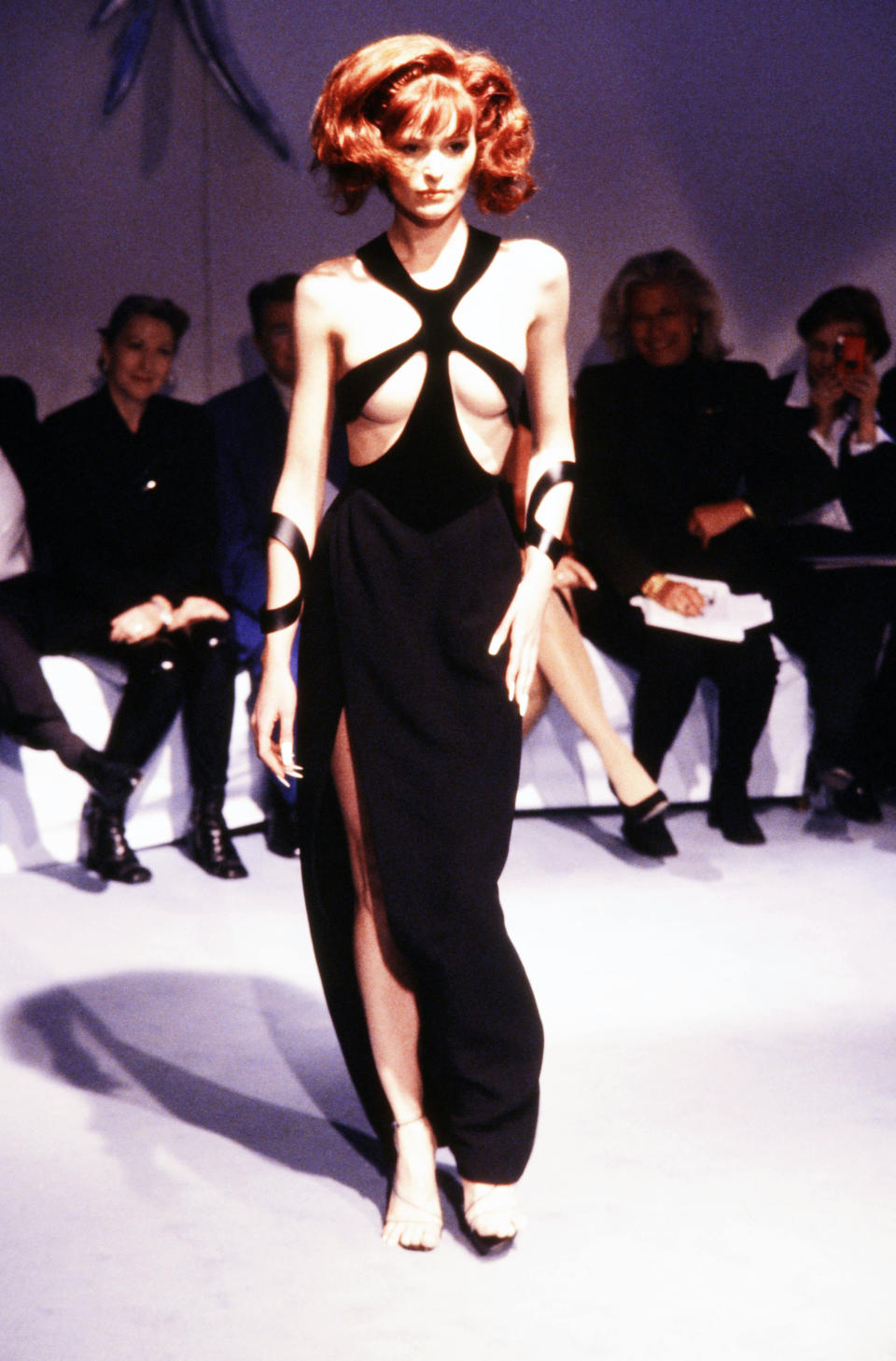
Giovanni Giannoni/WWD
WWD: What do you think about the public debate in recent years about women’s rights, and women speaking out about issues of discrimination and abuse?
M.T.M.: There are good aspects and bad aspects. These are issues I’ve always been sensitive to, and it was obvious this would happen eventually. It’s natural. Some movements are more positive and joyful than others. Some are a bit more icky, like #BalanceTonPorc [#ExposeYourPig, the hashtag used by France’s #MeToo movement]. I’m sorry, but an actress going to a producer’s room is not entirely innocent, let’s be honest. Everyone knows what goes on. That’s just hypocritical. What I like about the movements you mentioned is the fight against hypocrisy. Hypocrisy is not my cup of tea. But you know, speaking of criticism of my conception of femininity and women’s bodies, I was criticized a lot by Women’s Wear Daily.
They [WWD] have to politicize and intellectualize everything, in terms of morals and decency, and everything that touched on sensuality and sexuality. Everything was shot down instantly, and I just think it’s a shame and it’s sad, so I just move on. I don’t care.
Ultimately, society has proved me right. Everything I showed, that some papers described as pornographic, sexist or racist, is now mainstream. I legitimized materials like latex and vinyl.
I also did a lot of things that journalists completely failed to pick up on.
I always refused to use real fur. For years, I created gorgeous designs made of synthetic fur or wool. I always find solutions to problems or barriers. Fake fur has never had the softness and beauty of the real thing, so we made these beautiful long coats that required months of work, by cutting up fake fur and splicing it with strips of silk chiffon to give it movement. Sometimes, we would hand-embroider it with gold thread to give it the incredible silky finish of fur. We even embroidered a coat with “trembling” springs with a topaz on the end, mixed in with all that fur. No magazine has ever published a single photograph of these extraordinary fake fur coats, which were more beautiful than real fur.
They never talked about it, even though it was an extraordinary statement and I was vocal about it. There was no way I would torture animals for a piece of clothing.
I have some amazing ideas that will go even further, because the clothes of the future will be incredibly high-tech. These are clothes that react to the body. I think that the fashion of the future, at least what I want to do and what I’m able to do, is a combination of a very high-quality human hand — thanks to microcredit and communications, I can now source wool from Chile that is woven by hand by villagers using ancestral techniques — with sublime high-tech sophistication. These are clothes that are alive, that help the body.
WWD: Does this mean you’re planning a fashion comeback?
M.T.M.: It means I have very, very good ideas and I hope to execute them well. That’s all I will say.
WWD: I was under the impression that you were done with fashion.
M.T.M.: Yes, but fashion is still a great tool because it’s a three-dimensional art. It’s the most feral form of art, in the best sense of the word, meaning that it touches on the human, and that’s interesting. I’m not saying I’ll go back to creating full collections.
WWD: You predicted that in the 21st century, clothing would have a protective function. In recent years, athleisure has become a dominant trend. Is that what you had in mind, or are you disappointed by how it’s turned out, because there’s also a lot of sloppy dressing?
M.T.M.: No, I love all these clothes with well-thought-out, appealing design with aerodynamic lines. Sloppiness is very sad, not just in fashion. That’s not what makes me sad, though — it’s what’s happening in society as a whole, which is this grunge trend that I think is neither constructive nor positive, and certainly does a disservice to people. You see it in magazines and advertising, which emphasize this seedy aesthetic with girls with their toes pointed inward, dressed any old way, with greasy hair. This sinister look has also been popular in fashion shows. I don’t see the point of it.
I think that if you work in this industry, it’s to contribute something constructive. That’s my philosophy. That’s why I don’t watch violent films. I don’t understand horror movies and all that. It’s a lack of respect for women who are murdered in real life. Those are realities. But there are also marvelous things in this world, so let’s talk a bit about the marvelous things. It’s much harder to rise above things than to wallow in them.
WWD: A lot of your work has the same quality as old Hollywood movies — the same level of perfection as those great dance routines in the musicals.
M.T.M.: They invented a sublime art form: people like Busby Berkeley, Fred Astaire and Cyd Charisse, who was my friend and who walked in my show — a very important figure in my life. And the sensuality, the sex, the humor are there, because when you look at the choreography, it’s subtle but extremely sexy. It’s the same for all great works of art. We’re not talking about throwing a plate of tomato spaghetti in somebody’s face. It’s subtle, like a Billy Wilder movie.
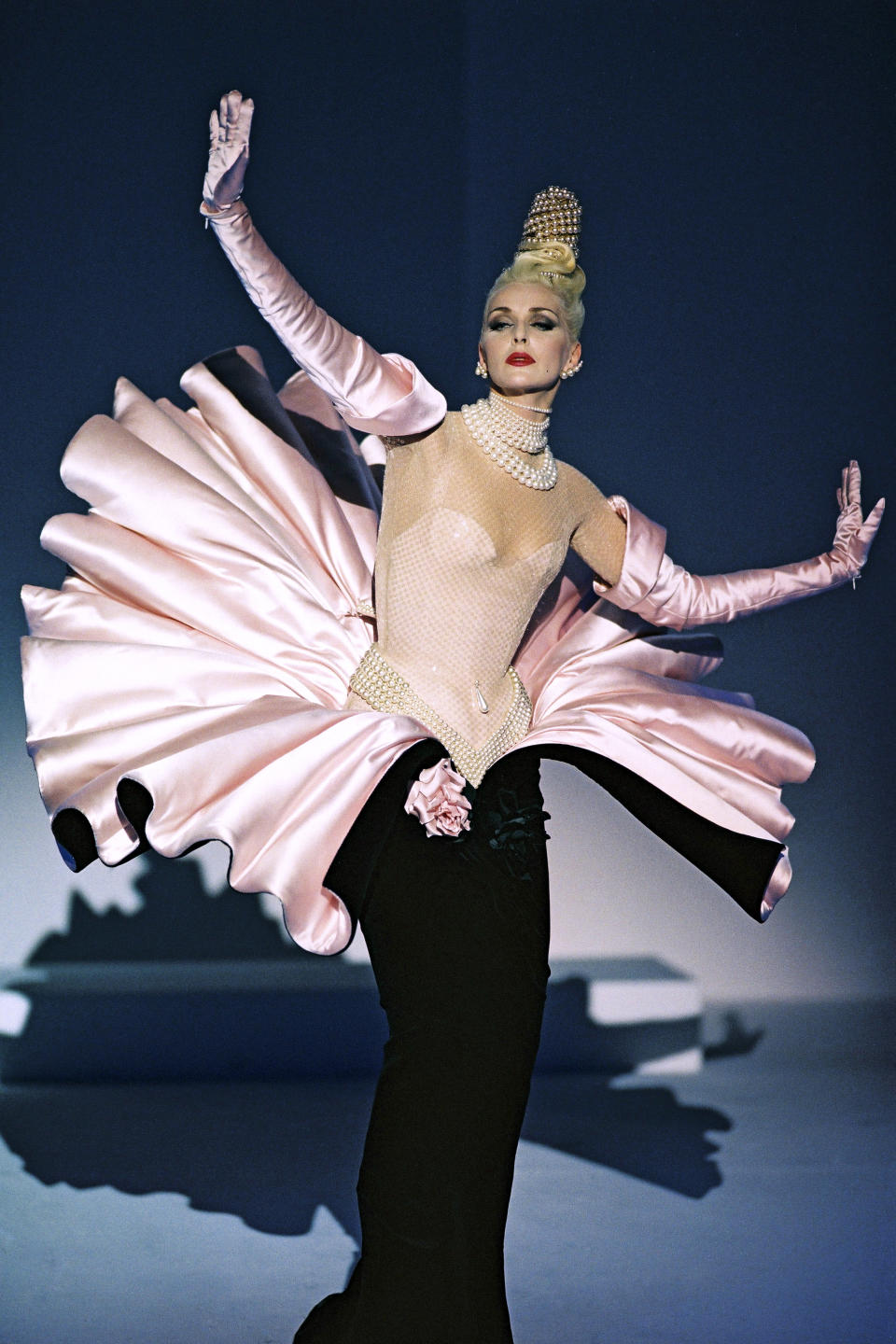
Patrice Stable/Courtesy of Musée des Arts Décoratifs
WWD: You’ve worked with industry legends like Diana Ross and Tippi Hedren. How does that compare with creating outfits for Cardi B or Kim Kardashian West?
M.T.M.: There’s no difference. I’m interested in people with strong personalities who know how to use that and invent something new. Cardi B is extremely sophisticated in her own way, she really takes it to the max. She has pushed the sexy “ghetto girl” aesthetic, with the fake nails, and the body language is just extraordinary — she’s taken it to the extreme and it’s incredibly effective. When I dressed her for the Grammy Awards in 2019, people were blown away. Her performance was incredible and people were stunned, because the direction, the lighting, the choreography — everything was flawless.
The same is true for Kim. She’s truly a self-made woman, and she says so herself. She says, “Not bad for someone who has no talent, right?” Well, her great talent above all is to have an incredible instinctive intelligence for business. Her business sense is incredible and she’s constantly evolving and transforming, always at a very high level. They’re all such hard workers.
WWD: When Cardi B came to the Mugler show in Paris in September 2018, she was in her makeup chair at 6 a.m., despite having performed the night before.
M.T.M.: They have to be fit like athletes. Recently, I was the guest of honor on “Germany’s Next Top Model” with Heidi Klum, and that’s what I told the aspiring models. You have to know you’re going to be stretched, physically, and you have to be ready for that. Cocaine is not going to get you through it.
WWD: Are you flattered or irritated by the fact that you continue to influence young designers today?
M.T.M.: I don’t feel flattered for a second. But it depends how it’s done. It can be touching, when it’s well done, well observed, but when it’s just a basic commercial take…I’m kind of used to it.
WWD: Some designers, like Alexander McQueen, were open about your influence on their work.
M.T.M.: McQueen did it in a gorgeous way, because he had a very strong personal universe and he was a true artist.
WWD: What projects are you working on?
M.T.M.: I have some exciting new fragrances in the works.
I’m also working on a personal exhibition of collages and photos for a gallery in Berlin, and I’m preparing another book of photographs with all the Polaroids I’ve collected over the years. I plan to continue designing for the ballet and there are lots of other projects in the works. I started working on two shows in China before the pandemic. We’ve made a lot of headway, but things are on hold for now.
I’ve also designed a furniture collection.
WWD: And if you do return to fashion design, what name will you design under?
M.T.M.: Mugler. It would be done with the house.
We’re talking about a few one-off pieces for special events, not a complete collection.
WWD: Helmut Newton was indirectly responsible for your career as a photographer, wasn’t he?
M.T.M.: He was the one who nudged me to do it professionally, because I’ve always been a photographer. I did my first fashion shoot at the age of 14 with a principal ballet dancer. I was the stylist, the lighting designer and the photographer, and I found the location. I did everything [laughs]. Helmut did my first two campaigns. As soon as Maison Thierry Mugler had a budget for a print campaign, I obviously reached out to Helmut because it was a perfect fit. I adored his work, it was totally in sync with my universe. He agreed right away, but very quickly, he told me: “Listen, you’re being a real pain. You know exactly what you want. Here, why don’t you take the camera and shoot it yourself?”
WWD: How did you know what to do at 14? Was it from watching all those movies?
M.T.M.: It came from watching Hollywood movies and looking at the work of great photographers like George Hoyningen-Huene, Horst P. Horst and others.
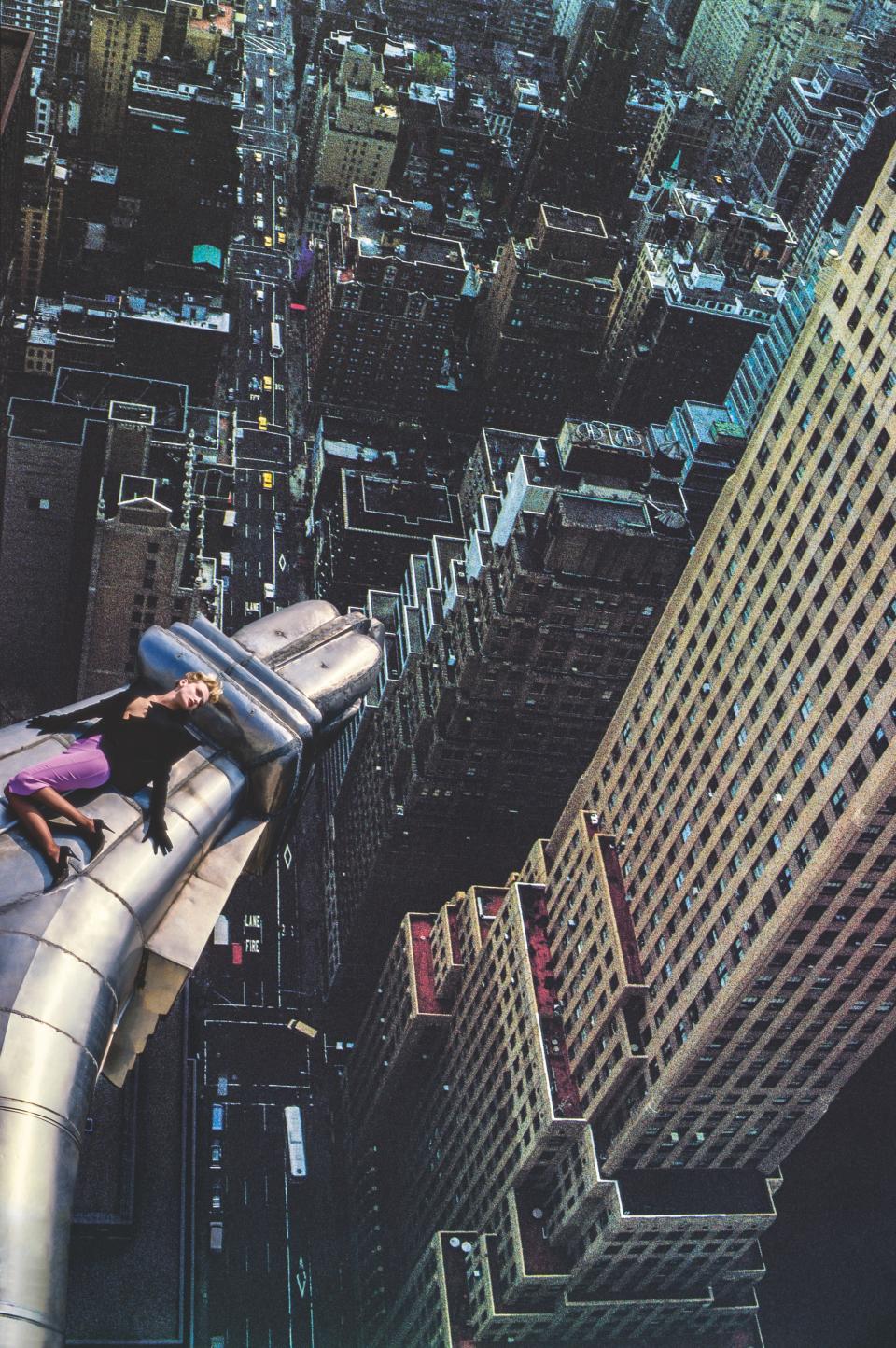
Manfred Thierry Mugler/Courtesy of Musée des Arts Décoratifs
WWD: You once said you were ready to die for beauty. You were talking about the process of shooting your famous image of Claude Heidemeyer lying on the Chrysler Building in New York City. Are you nuts?
M.T.M.: In that moment, I was.
WWD: Your desire for beauty is so overwhelming, you forget all physical constraints.
M.T.M.: Totally. You get so involved, you don’t worry about the danger. You’re just trying to get the shot.
I was two floors above, and even leaning out of the window as far as possible, I couldn’t get the right angle. We had this metallic ladder, so at the last minute, we stuck the ladder out the window and I lay on top of it like a pizza sliding into an oven, while the two assistants held down the other end so I wouldn’t fall off. There was no harness or anything. There was no time, and there was no point.
It lasted a couple of seconds. We had already rehearsed the pose, and I was able to capture the edge of the building with this huge drop, and the avenue going up vertically. I risked my life to get that shot, but that wasn’t the only time.
The same thing happened on the North Pole.
The model was perched on a very delicate spot, because the ice floe is hollow underneath. It’s like a bridge, because the waves carve away at it, so it’s very fragile, and the icebergs are moving.
WWD: Meanwhile, you’re setting off on these wild expeditions with suitcases full of couture gowns.
M.T.M.: Yes, and in the Sahara, it meant getting up at 4 a.m. to do Iman’s makeup by the light of a generator in the middle of the night. There’s a lot of courage and motivation that goes into creating these sublime images, for the sake of beauty.
WWD: Do you still have the travel bug, or has the coronavirus pandemic broken your stride?
M.T.M.: I’m waiting to have a private jet. I hope L’Oréal reads this article [laughs].
WWD: How did you come up with the brand’s signature shade of blue? It’s so distinctive, you know the brand even before you’ve seen the logo.
M.T.M.: Because it’s the reality of a color that’s completely magical, but not entirely real. It’s the blue of the sky, that’s all there is to it. All of those shoots [for Angel perfume], there was no post-production. It could involve waiting for hours. You have to pick the right season, for the images at least.
The Mugler blue has a touch of purple in it — a hint of holiness.
WWD: What about your stage shows? You were the first to turn them into major productions.
M.T.M.: The catwalk as I understood it was a kind of kabuki, a choreography of gorgeous human animals that chew up the scenery and the audience. They have an extraordinary animal presence and a control, a know-how.
I would have several soundtracks with different sounds and rhythms. If I felt the ambiance was flagging, I would send out a noise of thunder, or rain, or a beat. Other times, I would hold everything to respect the performance of these great models like Pat Cleveland, Katoucha Niane, Iman, Emma Sjöberg or Jerry Hall.
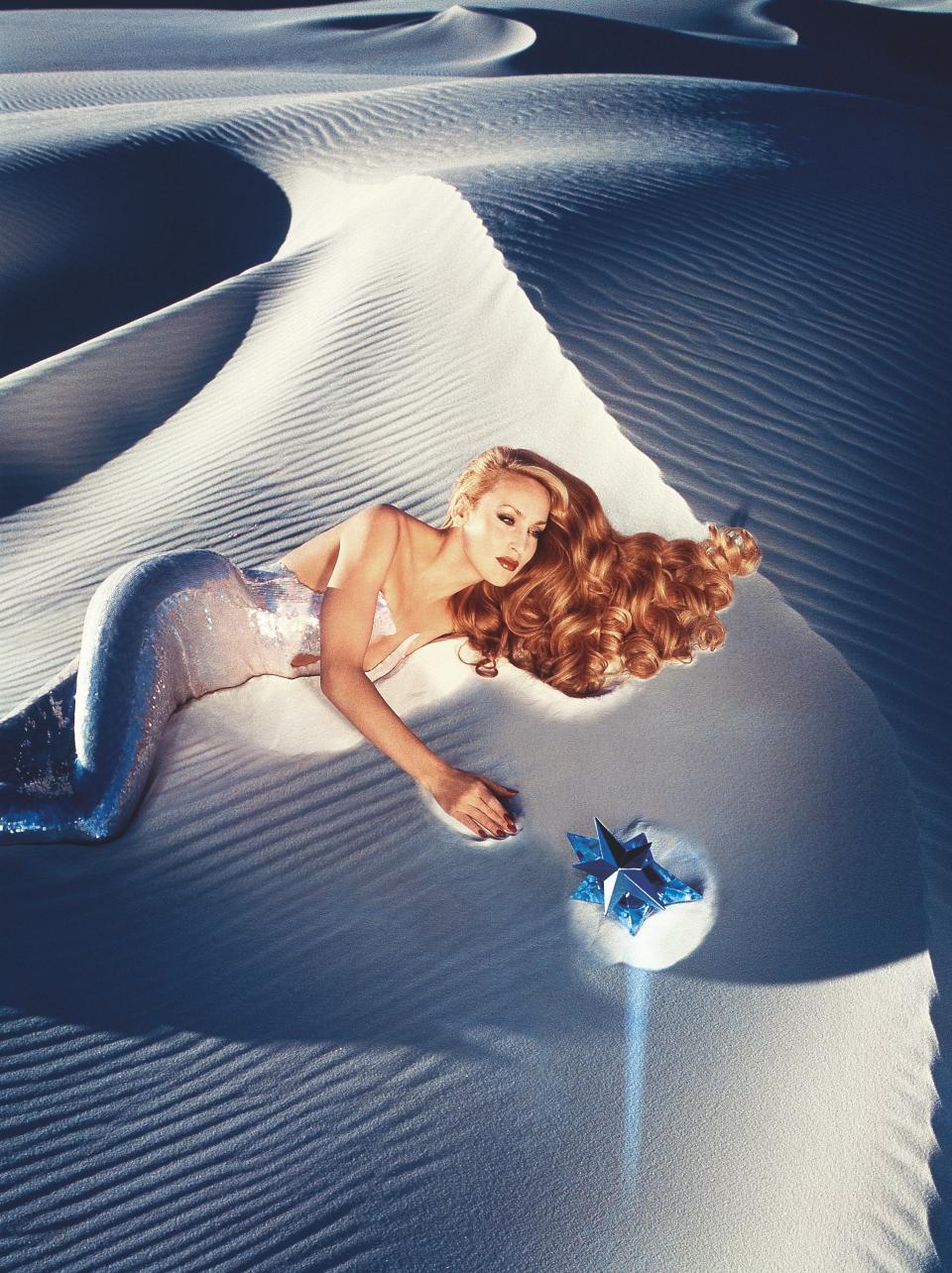
Manfred Thierry Mugler/Courtesy of Musée des Arts Décoratifs
WWD: Jerry Hall was known to take her time exiting the runway.
M.T.M.: Sometimes she would be off-beat and I would tell the production crew, “Don’t move. Stay on her.” And they would be pushing me to stay on schedule, but as far as I was concerned, she could take all the time she wanted.
Jerry is extremely generous. Doing makeup at 5 a.m. in a rotten motel next to White Sands, N.M., is not exactly a dream. Jerry, no matter the time of day or the conditions, was giving Jerry Hall to everyone from the firefighters on duty to the waitress serving pancakes at 6 a.m. If they wanted a picture with her, she would always pull out the stops. She’s always been very generous and very sure of herself, with a great sense of humor.
At the first VH1 Fashion and Music Awards in 1995, I did the opening show. All the big music stars were there, from Tina Turner to Madonna.
I was presenting a prize with Jerry, who was supposed to wear this gorgeous siren dress with these divine embroidered high heels. I look down at her feet, and she’s in comfy shoes. The dress was long, but as we’re about to go on stage, I asked her about it and she said: “Well, if they’re looking at my feet, then I’m in trouble.”

Reinier RDVA © 2021/Courtesy of Musée des Arts Décoratifs
WWD: The exhibition includes several portraits of you, but since you began the process of your physical transformation, there have been very few images of you, which has fueled public interest in your appearance. Do you feel like you have attained a form of perfection and harmony?
M.T.M.: Not really. Let’s say I’ve made some progress, I’ve regained my health and my body, but it’s not perfection. I’m still working on it.
WWD: Do you still work out a lot?
M.T.M.: Of course: sport and exercise, as well as yoga and meditation.
I’ve lost some mass because of the pandemic closing gyms. I have some gear at home, but it’s much harder. But even when I was bulkier, I was always very supple. I’ve worked on that my whole life.
The possibilities of the body are infinite. If you look at athletes, they’re always improving.
Above all, the relationship between the spirit and the body becomes clearer when you work on yourself. That’s when you understand a lot of things about life, human beings and yourself.
WWD: What is the most important thing you have learned during this process?
M.T.M.: Honesty and humility, I would say. The humility to look things in the face and to make choices that are not always easy, choices that are sometimes painful and allow you to grow.
SEE ALSO:
Willow Smith Fronts Mugler’s New Alien Goddess Scent
Mugler’s Towering Moment in Montreal
Thierry Mugler’s Cabaret Revue Debuts in Paris
Launch Gallery: Manfred Thierry Mugler's Most Iconic Moments
Best of WWD
Sign up for WWD's Newsletter. For the latest news, follow us on Twitter, Facebook, and Instagram.

